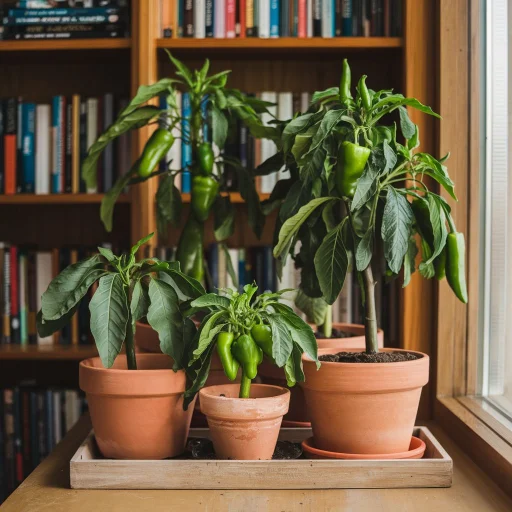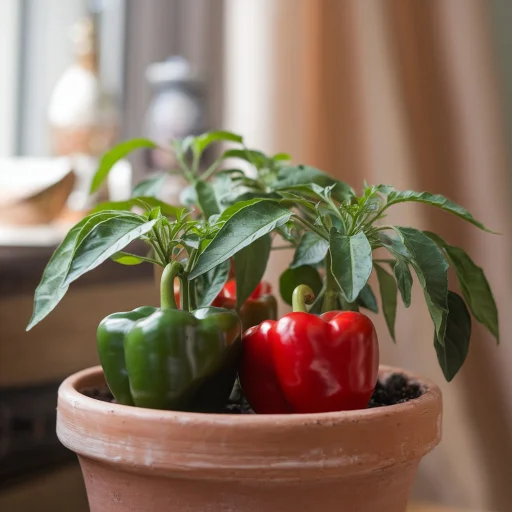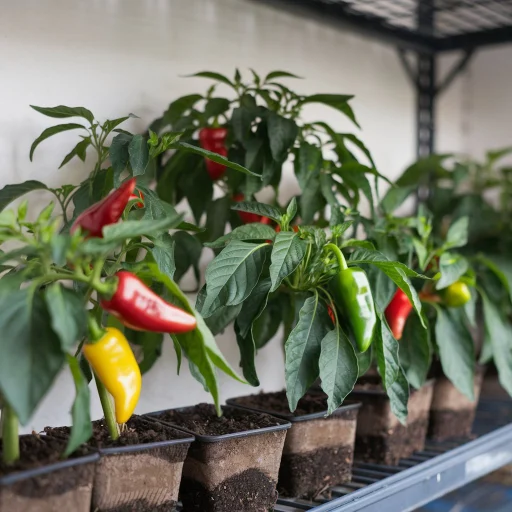Visit our online store for 100% handmade items!

In colder climates, peppers are often seen as a tender annual. Slightly before or after the first fall frost, many of these plants are torn out of the garden. But, did you know that peppers can actually be brought indoors, kept alive over the winter, and given new life in next year’s garden?
In today’s blog, we walk you through the steps you need to take to bring your peppers indoors to overwinter. We also explain the benefits that this approach has for getting a head start on your summer vegetable garden next year. So if you’re ready to start overwinter peppers indoors, pull up a chair and let’s dig in!

Why overwinter pepper plants indoors?
Overwintering peppers has some added benefits when it comes to preparing your vegetable garden for next year’s harvest. Having mature pepper plants ready to go will give you a great head start on the garden. You won’t have to wait for seedlings to grow before they are ready to bear fruit.
By getting a head start, you will be able to cut down on the time between putting on growth and fruit production. This means that you will be able to harvest peppers during a longer period of time. You can also increase your overall production.
Getting your pepper plants ready to come indoors
Look for your most productive and healthy plants to bring indoors. If you grew peppers in containers and in the ground, the ones in containers might be the easiest to not disturb their roots too much.
If you only grew them in the ground, don’t worry. You can still dig up some of your healthiest plants and prepare them to come indoors. When digging up your peppers, take care not to disturb the root ball too much.

Prepping the container and soil to overwinter peppers indoors
Make sure that you are placing them in a container with fresh potting mix. Be sure to feed them around the sides of the roots. Prune back the top growth to allow the roots to resettle themselves in their new home. Good practice is usually about half-three quarters. This allows for new root development underneath.
Pruning your pepper plants for overwintering indoors
Peppers grown in containers will need to be pruned as well. Pruning is typically done to fit the space that you are working with indoors. Many peppers grown outdoors have put on massive growth. They may be too large to bring indoors, especially if you are working with limited space.
Any pruning should be done with a sharp tool. Each cut should be made just above the bud. As you progress to the fall and winter months, you may see that the stems start to die back. Don’t worry as this is completely normal.
If you see any signs that your pepper plants are dying back, simply prune back these parts to where the plants are green. The leaves that are left on the plants may also turn yellow or fall off while the plants are indoors. Again, don’t panic as this is part of the process that the plants go through when entering their dormancy period indoors. Some plants may even be completely leafless during this period. Come spring, your pepper plants will start pushing out new growth and awaken from their dormancy.
Developing a care plan for your pepper plants while overwintering indoors
Temperature and light conditions for overwintering peppers indoors
Bringing your pepper plants indoors will require finding the right balance of temperature, light, and water. Paying attention to this balance will help your pepper plants survive the transition indoors.
Give your pepper plants a space indoors where they will face temperatures above freezing. For most people, this is probably in a windowsill or in front of a large window in their house. Or, perhaps you are lucky enough to have a sunroom to put your pepper plants in. Your plants need warmth and enough light to grow. Grow lights are also a good option here.
Watering peppers while overwintering indoors
Keep an eye on their water levels while indoors. Avoid overwatering. Wait until the potting mix soil has almost dried out before adding new water. You will not need to water your indoor pepper plants as much as you would have outdoors. Make sure that the plants are able to absorb the water. Any excess water should freely drain away from the plants.
You do not want the roots of the plants to sit in excess amounts of water. This can lead to root rot and a whole host of diseases.
Avoiding pests while overwintering peppers
Watch out for pests. Aphids are the common pest that is attracted to indoor pepper plants. Should they arrive, wipe and squish them off the plant with a damp cloth or spray the plant with water and they should leave.
Visually inspect your plants each day. This way, you can avoid pests. You can also monitor if your plants need more light or water to survive.

Bringing your peppers out of their winter dormancy and getting them ready for the summer garden
When there is roughly over a month until your final frost date, you can begin to prepare your overwintered pepper plants for outdoors. To get them ready, you may need to repot them into a larger container. You will also want to fertilize them to help them stay strong.
When they start to put on new growth, increase their water. This way, they can take up the vital nutrients to become healthy and strong again like they were last summer.
As you get closer to your final frost date, you can also transition your plants outside into a greenhouse or hoop tunnel. Here, they can slowly acclimate themselves to outdoor conditions. If there is a risk that temperatures might suddenly drop, you can always bring them back indoors temporarily.
Your overwintered plants will go through the same hardening off period as you would with new seedlings. But this time, your plants will already have a lot of mature growth when they enter your summer garden. This will allow them to quickly get to work setting fruit.
By overwintering your peppers indoors, you can extend your harvest. Your pepper plants are already used to producing fruit and all you are doing is bringing them out of their winter dormancy.
Final thoughts on overwintering pepper plants
Overwintering peppers does take some extra time and care. But, the benefits are numerous. Extending the life of your favourite pepper plants will put you on an early track to success in the summer garden. It will also increase your harvest and allow you to grow peppers longer during the season.
Until next time gardening friends, we hope that you give overwintering peppers a try this year. By following the tips in today’s blog, you will be well on your way to helping your peppers survive the winter. That way, they can come back stronger than ever in next year’s summer garden! For more fun and helpful tips on overwintering plants indoors, be sure to browse our other blog posts on overwintering begonias and geraniums indoors. You can also follow us on Facebook, Instagram, and Pinterest.



